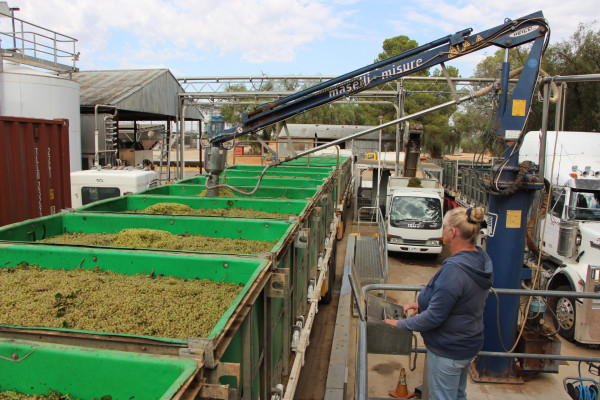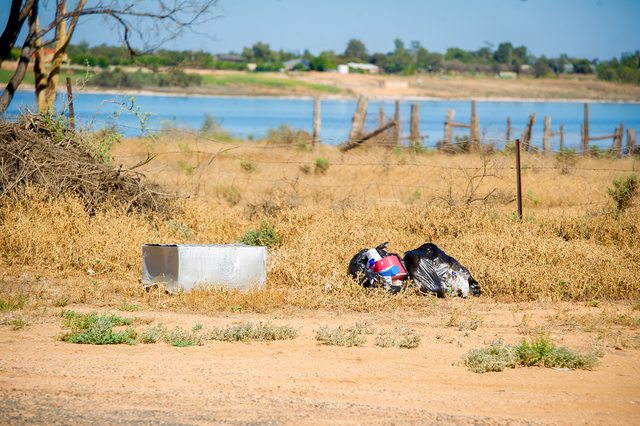WINE grape production in the Murray-Darling and Swan Hill wine regions dropped by almost 40 per cent in the past year, according to Murray Valley Winegrowers’ annual wine-grape crush report.
Production from independent growers and winery-owned vineyards in the region was collectively 205,000 tonnes, down on the 327,000 tonnes produced in 2022, and well below the 355,000-tonne average of the previous five years.
Many growers are facing their “most difficult time”, according to an industry leader.
The 2023 harvest report showed that independent growers were collectively paid $55.5 million for the 135,000 tonnes they produced, down 40 per cent from 2022.
This equates to a loss in income of about $122,000 for each of the 300 winegrowers in the region (and a staggering $245,000 when compared to the 2021 vintage), albeit depending on vineyard size, yield, disease, and saleability of fruit.
This year grower tonnages fell by 38 per cent to 135,000 tonnes (216,000 tonnes in 2022), while winery-owned vineyards decreased by 37 per cent, producing 70,000 tonnes (111,000 tonnes in 2022).
Most red grape prices continued to weaken in 2023.
The average price of cabernet sauvignon reduced by 12 per cent to $339 a tonne, shiraz averaged $337 a tonne, down by 13 per cent, and merlot was $336 a tonne, dropping by 15 per cent.
Pinot noir was in demand again this year, reflected in an improved average price of $715 a tonne, an increase of 3 per cent.
Mainstream red-grape prices are half what they were for the 2020 vintage.
White grape prices generally tended to decrease or were somewhat static.
Chardonnay averaged $383 a tonne, a reduction of 7 per cent on 2022 prices, gordo $335 a tonne (down 1 per cent), prosecco continued to lead the way with the whites priced at $661 a tonne (despite a fall of 12 per cent), sauvignon blanc held at $570 a tonne ($571 in the 2022 vintage), semillon $330 a tonne (down 6 per cent) and pinot gris was $532 a tonne (down 1 per cent).
Across all varieties in 2023, the average price was $412 a tonne, down 4 per cent from the $428 a tonne recorded in 2022.
Chardonnay maintained its top position on the production list with 51,000 tonnes (83,000 in 2022), followed by shiraz with 46,000 tonnes (70,000), then cabernet sauvignon 20,000 tonnes (40,000), sauvignon blanc 18,000 tonnes (22,000), pinot gris 13,000 tonnes (23,000), gordo 10,000 tonnes (19,000) and merlot 8000 tonnes (18,000).
Prosecco made its way into the top 10 for the first time with about 4500 tonnes (3850 in 2022)
MVW chief executive Paul Derrico said the small crop and reduction of income had been “distressing” for many growers.
“The devastating effect of poor red prices, widespread disease pressures through the growing season, and to a lesser extent localised flooding, has seen many growers face the most difficult time they would have experienced growing wine grapes,” he said.
“Timing of sprays, timing of vine growth stages, chemical choices and availability, chemical rates, cultural practices, site-specific conditions, and general vineyard management all combined to determine whether or not growers could save their crops this year.
“The weather conditions were relentless and while some thought they may have had it under control early, they soon discovered that it wasn’t.
“For some, crop losses have been significant. For others, it hasn’t been as bad, but it is rare to find a grower that hasn’t been affected in some way by the spring weather events.
“Fruit that was managed through to vintage relatively unscathed was basically all sold, albeit many reds were sold below the cost of production.”
Mr Derrico said varieties that were in demand and reflected better pricing included pinot noir, prosecco, pinot gris and sauvignon blanc.
“The effect of reduced income for the industry will not only be felt by growers, but all the connected employees and businesses in the region, evidenced in part by the recent announcement that Treasury Wine Estates will cease operating at its Lindeman’s site at Karadoc next year,” he said.
“Whilst the immediate outlook for whites is relatively stable and thankfully half the wine grapes produced in the region are whites, we have observed several wineries recently suggest that vintage 2024 will see a continuation of oversupply of the main red-grape varieties.
“And, if not for the major crop losses in 2023 due to disease (predominantly downy mildew), then we believe that significant volumes of reds would have remained unsold this year.
“In fact, growers of contracted reds may have already been approached by their winery to look at reducing yields or mothballing, such as enforced caps or renegotiating contracts by mutual agreement.
“We urge all growers to consult their winery or regular buyer as soon as possible to gain direction for the upcoming challenges.
“Growers need to do this now, the increased costs at the vineyard level suggest the price to recover the cost of production is likely to be much higher than the likely red grape price to be offered next season.”







